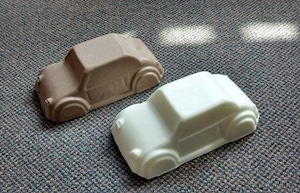Research continues to improve performance and processability with an eye on deployment in auto applications.
November 4, 2016

Vehicle lightweighting is a high-profile trend in the auto sector, contributing to lower emissions and improved fuel economy. Here, plastic composites are playing a key role in this movement and their green credentials are receiving an additional boost through the use of natural fillers and reinforcements coming from the forestry and agricultural industries.
|
Biobased foam employs lignin as component. The pulp and paper industry waste product is normally landfilled or incinerated. |
With its considerable presence in both agriculture and forestry, it perhaps comes as no surprise that Canada is a hotbed for development of green composite technology. Over the past 10 years, the National Research Council Canada (NRC; Ottawa, ON) has headed a sustained effort to add value to biomass residues coming from the forestry and agricultural sectors into a large variety of applications, including biocomposites for automotive components. “We have tested several types of natural fillers such as wood flour, flax flour and rice hulls,” notes Karen Stoeffler, PhD, Polymer Bioproducts Team Leader - Automotive & Surface Transportation, NRC. “We have developed polyolefin/wood flour compounds with up to 40% renewable content exhibiting the same mechanical and thermal properties to polyolefin/talc compounds commonly used in automotive interiors for an equivalent density and potential cost reduction,” she notes. “We can also integrate natural fillers in engineering polymers such as polyamide for under-the-hood and exteriors applications.”
Karen Stoeffler will be speaking on the topic of polymer composites for automotive applications at Expoplast in Montreal. Hundreds of exhibitors will showcase injection molding machines and other plastics processing systems, materials and additives, rapid prototyping services and equipment, and much more at the event on Nov. 30 and Dec. 1, 2016. Register to attend now! |
NRC has also replaced glass fiber in thermoplastic and thermoset composites with long natural fiber reinforcements coming from agricultural fibers (flax, hemp) or engineered cellulosic fibers in the form of continuous rovings, mats or fabrics. “We have recently developed a polyester/flax fiber system to replace polyester/glass composites used in a transportation application offering equivalent mechanical properties and fire resistance for a lower density,” says Stoeffler.
Natural fibers are not as strong as glass fibers, but they have a much lower density (1.3 g/cm3 vs 2.5 g/cm3) and still offer very interesting mechanical properties according to Stoeffler. “In order to achieve similar mechanical performance, several strategies can be used. For example, we can use higher levels of fibers, or work on hybrid systems by combining natural fibers and glass fibers.”
|
Forming-stamping technology is a rapid process for processing organo-sheets at a rate acceptable to the auto sector. |
NRC is also working on technologies to mitigate some of the intrinsic drawbacks of natural fibers, which are more sensitive to moisture, can be flammable and can generate volatile organic compound (VOC) upon processing. “For example, we have patented a cost-efficient and easy method to absorb moisture in natural fillers and fibers, thus avoiding the need for pre-drying those materials before processing,” says Stoeffler. “We have also developed low-cost surface treatments to reduce the flammability of natural fibers.” Currently, NRC’s Polymer Bioproducts team is working toward solutions to control and reduce VOC and odors generated during the processing of biocomposites at elevated temperature (>200°C).
Besides composites, NRC is actively investigating bio-based foams for automotive cushioning applications, in particular the use of lignin, a natural biopolymer and a by-product from the pulp and paper industry. It is available in large quantities and at low cost in Canada since it is currently being landfilled or burned, according to Stoeffler. NRC is currently working on polyurethane/lignin foams as a low-cost, partially biobased alternative for polyurethane petroleum-based foams.
NRC has also recently invested in a 1,250-ton forming-stamping press located at its Boucherville facilities (Quebec, Canada). Forming-stamping is a process that has been widely used for metals. However, it can also be used to form high-performance composites within short cycle times, compatible with the cycle times required for manufacturing of large-scale composite parts for structural applications in the automotive industry. The process starts from thermoplastic sheets (also called organo-sheets) reinforced with synthetic fibers (unidirectional fibers or fabrics). Those organo-sheets are heated in an infra-red oven to become malleable, before being stamped (i.e., compression-molded at high speeds).
“Our goal is to allow the transportation industry, to use this facility to accelerate its composite products development and prototyping. They can count on a state-of-the-art, large-scale, accessible and confidential testing platform, and on the capabilities provided by NRC’s experts,” concludes Stoeffler.
About the Author(s)
You May Also Like






